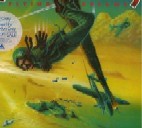Cuttlefish
Posts: 2454
Joined: 1/24/2007
From: Oregon, USA
Status: offline

|
November 8, 1944 (southern strike force)
Location: ?
Course: ?
Attached to: TF 27
Mission: Surface Combat
System Damage: ?
Float Damage: ?
Fires: ?
Fuel: ?
Orders: Engage enemy forces at Iwo Jima
---
Lieutenant Sugiyura’s gaze keeps straying north, to where he knows that Ise and Hyuga are at the moment engaging enemy battleships. Captain Ishii notices his looks and interprets them correctly.
“You understand, Sugiyura,” he says, not without sympathy, “that if we are to fulfill our mission it is best if we are not drawn into such a battle.”
“Yes, Captain,” says Sugiyura. But the look on his face says that while hunting enemy transports is no doubt necessary he longs for the chance to engage an enemy capital ship.
The southern striking force is currently east-southeast of Iwo Jima and heading west. They have been tracking the battles to the north for over an hour on radar and via radio intercepts but they themselves have seen no sign of the enemy as of yet. No planes, no ships have come out to challenge them.
“Bridge, this is Takahashi,” comes a voice through the speaking tube. “I am picking up new contacts ten miles ahead. They are just clearing the island and moving south, sir.”
Ishii raises an eyebrow. “Transports trying to escape the fighting?” he says to Lieutenant Miharu.
“It seems possible, sir,” says his executive officer. On Hibiki’s crowded bridge several officers raise binoculars and scan the sea ahead, though of course it is not yet possible to see anything.
Apparently other ships have also detected the new force, for Yamato signals a course change 20 degrees to port. As they move to intercept silence falls on Hibiki’s bridge except for an occasional murmur. Everyone waits tensely as they wait to see what they are about to engage.
Before long the enemy ships change course to the west. They have no doubt detected their pursuers and are attempting to evade. This, and the fact that the Japanese ships continue to rapidly narrow the distance, indicates clearly that they have found what they came here to find – enemy transports.
Hibiki’s deck plates thrum as the Japanese increase speed to 26 knots. Before long the masts of enemy ships become visible. Not transports but freighters, big ones, in three columns of six ships each. They are screened by six destroyers, which are even now turning back to meet the Japanese.
The freighters are slow, however, and low in the water. It is obvious that what they have found is the enemy’s main supply convoy. Captain Ishii cannot repress a tight smile of satisfaction. This is a prime target.
The nine Japanese destroyers are deployed forward in a line to meet the oncoming enemy destroyers. Already Yamato and Musashi’s forward turrets are booming, their shots ranging beyond the destroyers to find the freighters. As their big shells churn up huge columns of water among them the freighters begin to spread out and disperse. One 18.1” shell scores a direct hit and the luckless freighter slews to a halt, fire and smoke billowing upward.
On Yamato a pennant flutters upward ordering the destroyers to prepare a torpedo attack. Lieutenant Sugiyura groans.
“Not yet!” he says. “The range is too great. These tubs can’t get away, we should wait!”
“I agree,” says Ishii. “But it is not my decision. Prepare your torpedoes, Lieutenant.” As the range closes to 17,000 meters the Japanese destroyers change course to the south and unleash a swarm of Type 93 torpedoes. As these churn towards the enemy the ships come back around to the west. The range to the destroyers closes rapidly.
“Reload torpedoes!” orders Sugiyura. On the torpedo deck, as they have drilled so many times, Hibiki’s torpedo crews begin the difficult job of reloading the tubes.
Hibiki’s course brings her towards two of the enemy destroyers. At 9000 meters Ishii orders Kuwaki to open fire on the one to port. A moment later Hibiki’s forward 5” guns boom. The shells fall long and to the right. Corrections are made as the guns reloaded.
Their target is the U.S destroyer Benham, whose guns are already firing on Yamato. Benham and Stack have moved out a bit ahead of the others and are heading with single minded determination towards the big battleship. Their determination to launch a torpedo attack is clear.
Ishii orders an abrupt course change to port, screening the battleship and unmasking his rear battery. On the third salvo a cheer erupts from the crew as one of her shells strikes Benham near the base of the tower. A second hit a moment later punches a hole in her weather-streaked flank. Smoke and flame come streaming out as the shell detonates somewhere deep within.
Benham comes around and launches torpedoes. These churn aft of Hibiki and one strikes Yamato near the bows. The big battleship seems to scarcely notice the sting and continues to plunge forward.
The battle devolves into a confused, swirling destroyer duel. The Japanese battleships and cruisers try to remain above the fray and go after the transports but the American destroyers make this difficult. Even as Ishii tries to kill them he is impressed by the skill and bravery shown by the enemy crews.
Hibiki now closes in on Benham, pounding her with repeated hits. The range closes to 4000 meters and Kuwaki’s well-trained men are not missing their chance. The enemy destroyer is soon battling several fires and is obviously in serious trouble.
Not far off destroyer Dale, having just executed a torpedo attack against Suzuya, notices Benham’s plight. Dale moves in on Hibiki from astern and opens fire.
Hibiki, intent on her prey, does not recognize the danger until two 5” shells geyser into the water less than 100 meters to starboard. The ship thrums from the underwater concussion of the near-misses. A moment later geysers erupt to either side, sending water cascading over the ship.
“We’re straddled, sir,” notes Lieutenant Miharu, somewhat unnecessarily.
“Helm, change course ninety degree to port,” barks Ishii. “Kuwaki, your new target is that destroyer astern. Fire when ready.”
Hibiki comes about and opens a brisk duel with Dale. Hibiki scores first as the aft turret sends two shells ripping into Dale right at the water line.
“Torpedoes ready, sir!” announces Sugiyura. He is proud of his men – fourteen minutes and ten seconds, all while under fire.
“Good,” says Ishii. “There’s your target, Lieutenant.” He points to Dale, some 7000 meters distant.
“Yes sir!’ grins Sugiyura. He checks to make sure that no Japanese ships are in danger of moving behind Dale and then orders the attack. Dale tries to turn away from the Type 93s and her anti-aircraft guns fire into the sea in an attempt to detonate the torpedoes. To no avail, however; one of them catches her. The resulting blast lifts the stern free of the water for a moment, and then it settles back heavily.
“Well done,” says Captain Ishii. He orders his ship to cease fire; Dale has stopped shooting at them and is obviously doomed. With a few moments of breathing space he surveys the battle still raging around him.
Yamato and Suzuya have been torpedoed but do not seem badly hurt. Fujinami has been hit hard; the Japanese destroyer is burning and has a slight list. Five of the six enemy destroyers are out of the fight and sinking; one, Stack, took a full broadside from an annoyed Musashi’s main guns and is already gone. Not too far off the last enemy destroyer still fighing, Aylwin, is exchanging fire with Teruzuki. Both destroyers have already scored against one another and Teruzuki is trailing smoke.
Ishii orders Hibiki to open fire on Aylwin. Again Hibiki scores hits, as do several other ships. Aylwin is torn by a storm of shells and left sinking.
The bulk of the enemy fire has been directed against the larger Japanese ships; all have taken several 5” hits but none are seriously damaged. Now the pursuit of the scattering enemy freighters begins in earnest.
The rest of the action is less of a battle than it is a massacre. Ishii and many others aboard Hibiki are not blind to the plight of the merchant mariners caught under their guns. It is not pretty, and it is not bushido; but it is war and it must be done.
In the end ten of the eighteen freighters are sunk or left sinking; most of the remainder are damaged. The survivors are so widely scattered that it would take the rest of the day to hunt them down, and this is time the Japanese do not have, not if they are to have a chance to see home again.
Already they may have stayed too long. But as Admiral Tashiro orders his ships to regroup and head for Tokyo they believe they have done what they came here to do.
Nor are they wrong. Gone are most of the supplies for the men in the transports and for those already ashore. The American troops are too strong to be dislodged by the Japanese defenders but their offensive capacity has been crippled. It will take weeks to replace the destroyed supplies and in the meantime the battle for Iwo Jima will turn into a bloody stalemate.
Against all odds Yamamoto’s plan has succeeded. Now all that remains to be seen is whether the surviving Japanese ships can reach home once again.
|
 Printable Version
Printable Version










 Excellent!
Excellent! 















 New Messages
New Messages No New Messages
No New Messages Hot Topic w/ New Messages
Hot Topic w/ New Messages Hot Topic w/o New Messages
Hot Topic w/o New Messages Locked w/ New Messages
Locked w/ New Messages Locked w/o New Messages
Locked w/o New Messages Post New Thread
Post New Thread